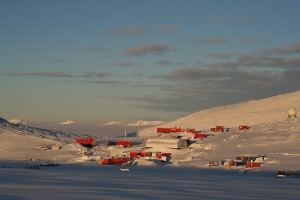Did you know about the troll in Antarctica?
Troll is Norway’s research station in Antarctica and is situated in the Norwegian sector which is named Dronning Maud Land.
 Evening sunshine at Troll. Photo: Stein Tronstad / Norwegian Polar Institute
Evening sunshine at Troll. Photo: Stein Tronstad / Norwegian Polar Institute
The station is far away from the coast and stands on bare ground in an area called Jutulsessen, surrounded by mighty peaks and nunataks. Most of the other research stations in Antarctica rest on snow or ice. All Troll’s research equipment, fuel and other supplies must be transported a full 275 km from the coast. This arduous, time-consuming journey over the ice is undertaken by convoys of tracked vehicles. In the summer, however, it is fairly easy to reach the station by air. Troll Airfield, with its 3000 meter long runway, is located on a patch of rock-hard blue ice, just a couple of kilometers from the research station.
Troll was first set up by the Norwegian Antarctic Expedition of 1989–1990 and was originally meant for summer use only. The station is owned and run by the Norwegian Polar Institute, and was substantially upgraded in 2005, when it first opened as a year-round station. H.R.H. Queen Sonja inaugurated the new station.
The station can accommodate eight people in the winter and many more in the summer. It serves as a meteorological station, a radiation observatory for measurement of radiation including UV wavelengths, and a field station for glaciological, biological and geophysical field research programs.
Troll is completely isolated in the winter season, which lasts from March to October, but the six members of the overwintering team have contact with the outside world through satellite links. The weather can sometimes be extreme, with temperatures as low as -45°C and wind speeds up to 60 meters per second, but the station was built to tolerate such conditions.